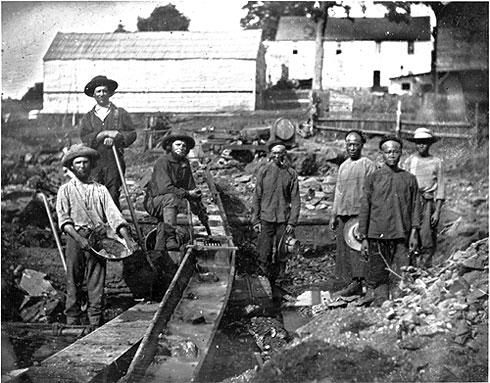Affiliate Disclosure: The owners of this website may be paid to recommend the following companies: Goldco, Augusta Precious Metals, Noble Gold Investments, Birch Gold, and Regal Assets. The content on this website, including any positive reviews of the mentioned companies, and other reviews, may not be neutral or independent.
The history of the gold rush is filled with stories of Prospectors, Boomtowns, and Mining camps. These stories are ripe for the retelling, as they highlight the fascinating characters and events that made California so special. There are also many fascinating facts about the men and women who worked in the mines. But, to understand the history of the gold rush, you must first understand how the process of mining works.

Mining camps
In the early days of the gold rush, most immigrants were men. Although women were permitted to work as miners, a newspaper photographer’s stipulation against photographing women in disguise meant that men largely populated the mining camps. Women, however, eventually learned to become comfortable in their gender roles and began dancing at camp dances. This practice eventually led to cross-gender practices, such as women taking turns dancing with men.
As the Gold Rush raged across the West, the mining camps were ephemeral. As people flocked to the Sierras to seek their fortune, the placer mining business dwindled. In ten years, weeds overtook the site and hid man’s work. After the rush ended, abandoned camps and buildings were left to rot and decay. The ruins of abandoned mining camps, however, remain as monuments to the days of gold rush.
The History of the Gold Rush

In addition to the gold rush, mining camps acted as centers of commerce, transportation, and supply. Many remained active after the placer mines were exhausted. These towns also became local government seats and centers of activity. Some of these towns are still in use today. As the gold rush swept into California, more prospectors began to head eastward, furthering the mineral discoveries that dominated the Sierra range. Bodie, one of the best preserved ghost towns, is located in the mountains.
A major challenge for the gold miners was competition. The more crowded the mining region, the less gold there was. Miners became territorial over their land and forced other nationalities out of the mines. Ultimately, approximately 120000 Native Americans lost their lives during the Gold Rush due to starvation, disease, and homicide. The gold rush left a lasting legacy, including a massive cultural impact.
Prospectors
Gold rushes were hugely popular during the late nineteenth century, when millions of people came to California in search of gold. Thousands of immigrants from China, Mexico, Central America, Britain, and Spain joined the rush and made the journey to California. Several hundred Turkish and Filipino miners also arrived in California. White American prospectors, however, tried to displace the foreign miners and take their gold, and foreign miners were often attacked by white American miners.
While gold was an attractive investment, early discoveries were met with skepticism, and local newspapers didn’t give much notice. However, a Mormon leader named Samuel Brannan and a strong religious leader, increased the chance that people would believe that gold was hiding in the hills. As the number of miners increased, the strike rate of gold dwindled. The discovery of gold by Samuel Brannan in 1848 increased the chances of people believing in the elusive gold.
he History of the Gold Rush
Many migrants spent all their savings in the trans-continental journey. The gold rush triggered a huge surge in the demand for basic supplies, which caused prices to skyrocket. While the Canadian authorities insisted that prospectors take one year’s worth of supplies, many of these immigrants arrived in San Francisco without much, if any, supplies. Prospectors were often forced to stay in tents and take in supplies in advance of their gold-mining expeditions.
While most prospectors were young men, some were also women. About 90% of them were born in the United States, while the remainder migrated from England and Ireland. They were also displaced from their homes by violent pressure and treaty negotiations. The mining and smelting boom forced the native people to relocate. Furthermore, the mining of gold spurred the migration of entire Native American communities from the East to the West.
The History of the Gold Rush

Boomtowns
Many early boomtowns experienced a dramatic increase in population and economic activity during the Industrial Revolution. These towns, which had been relatively poor and backwaters in pre-industrial England, transformed into major urban centers. Their growth did not directly depend on local resources, such as gold, but instead took advantage of great infrastructure and large seams of cheap coal. However, the gold rush did not end there, and boomtowns grew far beyond their original purpose and quickly became the epitome of American urbanization.
In the 1878 Gold Rush, two towns exploded. Leadville, Colorado, and Tombstone, Arizona each saw a dramatic increase in population. In the same period, the population of Pennsylvania’s Oil City increased from 300 to 25,000, indicating that the boom had spread beyond the Klondike. In Oklahoma, the boomtown spread into Oklahoma, Texas, and Indiana. During World War I, munitions production expanded the population of several western towns, including Oklahoma City and Guthrie.
The Gold Rush led to many boomtowns and other communities, which served as a place for people to camp, buy mining equipment, and get a good night’s sleep. In these communities, people found comfort in socializing, buying new mining equipment, and spending time at bars. The resulting boomtowns increased rapidly in popularity and profit. Often, however, people were disheartened with their lack of success in the gold fields and turned to these towns to buy more mining equipment and hope for better luck in the future.
Among the many places that were popular during the Gold Rush, Nevada City was the largest. The city was founded in 1852 and soon became the center of gold rush activity in the region. However, the town’s popularity declined by the end of the century. It is still a popular ghost town, located near Grass Valley and Nevada City. It is interesting to note that some of the original boomtowns were abandoned after the gold rush.

Sam Brannan’s shrewd tactics
During the Gold Rush, Sam Brannan was one of the most successful entrepreneurs. He ran a newspaper and general store in San Francisco and spread the news of his find by running through the streets, yelling “Gold! Gold in the American River!” and selling picks and shovels to the arriving miners. Today, his name is synonymous with the Golden State.
After becoming a Mormon, Brannan converted and settled in New York, where he became an influential leader among the Mormon population. He eventually led a ship of 200 Mormons to the gold fields in Northern California. He was then responsible for the tithes of his church members. Apparently, some of his money never made it to Utah. Brannan’s shrewd tactics were not without controversy.
Sam Brannan’s shrewdry tactics in the history of the Gold Rush are well-documented. His success in the California gold rush was partially due to his shrewd business decisions. After all, he owned a store in the San Francisco area, which was the only store between San Francisco and the gold fields. As a result, he had a significant impact on the California gold rush, and his actions earned him the famous maxim, “You get what you pay for.”
The first big gold discovery was not made by Brannan himself, but by other people. His business strategy was to buy gold pans from prospectors and sell them for fifteen dollars. Brannan became a millionaire, despite not digging gold himself. As his investments increased, he expanded his business and opened more stores. In time, he even owned several buildings in San Francisco and Sacramento.
Inflationary shock
Inflationary shock and the history of a gold rush are linked to one another. While gold was not an actual cause of the 1848 U.S. gold rush, it did increase the quantity of money available to people and led to an ensuing inflation. Gold production during a gold rush correlated with a 30% increase in wholesale prices. The gold rushes reversed the deflationary trend of decades and helped indebted farmers and ended the Populist Party.
Early macroeconomic statistics tend to be based on small samples and rely on volatile components. Christina Romer documented early real GNP estimates and price-level measures and suggested that these may be statistical artifacts. However, a gold rush was a time of great optimism. Moreover, gold was a highly speculative commodity and was only profitable if it was available at a high price.
The gold rush induced the most extreme demand for labor in history. As the supply of common labor decreased, wages skyrocketed. According to Robert Margo, (2000), the demand for labor drove wages up by 515 percent from 1847 to 1849. However, the real wages fell as more settlers arrived in the 1850s. By 1860, wages were almost four times higher. The gold rush was a significant transitory shock in Australian history and helped integrate the gold-rich states into the larger U.S. economy.
The gold-rush-era gold rush is also important because it shows the emergence of the gold standard and the rise of the price level. It is also a time when the world economy is not on an even footing and the price level is not in balance. During the classical gold standard, a nation’s money stock did not grow quickly enough to offset the demand for gold. Therefore, gold reserves began to shrink as a result.


4 thoughts on “The History of the Gold Rush”
Comments are closed.